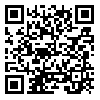Volume 12, Issue 4 (2-2020)
ijhe 2020, 12(4): 661-678 |
Back to browse issues page
Download citation:
BibTeX | RIS | EndNote | Medlars | ProCite | Reference Manager | RefWorks
Send citation to:



BibTeX | RIS | EndNote | Medlars | ProCite | Reference Manager | RefWorks
Send citation to:
Nasri O, Yunesian M, Alimohammadi M, Shalyari N, Masoomi S, Shamsipour M. An investigation of validity and reliability of a questionnaire for use-patterns of household cleaning, personal care, and cosmetic products. ijhe 2020; 12 (4) :661-678
URL: http://ijhe.tums.ac.ir/article-1-6335-en.html
URL: http://ijhe.tums.ac.ir/article-1-6335-en.html
1- Department of Environmental Health Engineering, School of Public Health, Tehran University of Medical Sciences, Tehran, Iran
2- Department of Environmental Health Engineering, School of Public Health, Tehran University of Medical Sciences, Tehran, Iran AND Department of Research Methodology and Data Analysis, Institute for Environmental Research, Tehran University of Medical Sciences, Tehran, Iran
3- Department of Environmental Health Engineering, School of Public Health, Tehran University of Medical Sciences, Tehran, Iran AND Center for Water Quality Research, Institute for Environmental Research, Health Equity Research Center, Tehran University of Medical Sciences, Tehran, Iran
4- Department of Biostatistics, School of Public Health, Tehran University of Medical Sciences, Tehran, Iran
5- Department of Research Methodology and Data Analysis, Institute for Environmental Research, Tehran University of Medical Sciences, Tehran, Iran AND Center for Air Pollution Research, Institute for Environmental Research, Tehran University of Medical Sciences, Tehran, Iran ,shamsman87@yahoo.com
2- Department of Environmental Health Engineering, School of Public Health, Tehran University of Medical Sciences, Tehran, Iran AND Department of Research Methodology and Data Analysis, Institute for Environmental Research, Tehran University of Medical Sciences, Tehran, Iran
3- Department of Environmental Health Engineering, School of Public Health, Tehran University of Medical Sciences, Tehran, Iran AND Center for Water Quality Research, Institute for Environmental Research, Health Equity Research Center, Tehran University of Medical Sciences, Tehran, Iran
4- Department of Biostatistics, School of Public Health, Tehran University of Medical Sciences, Tehran, Iran
5- Department of Research Methodology and Data Analysis, Institute for Environmental Research, Tehran University of Medical Sciences, Tehran, Iran AND Center for Air Pollution Research, Institute for Environmental Research, Tehran University of Medical Sciences, Tehran, Iran ,
Abstract: (2594 Views)
Background and Objective: Regular use of household cleaning products and cosmetics can result in adverse consequences for human health. Therefore, the knowledge of consumption pattern of these products can help to evaluate the effects and finally control the consequences of their inappropriate application. As there is not an appropriate tool for evaluating public use-pattern for these products in Iran, we studied the reliability and validity of a questionnaire designed for the use-patterns of these products.
Materials and Methods: In the present study, a questionnaire, which was previously applied in similar studies for this purpose, was first translated to Persian. Then, some changes were made in the questionnaire according to the studied population. In the next step, the assessment of both content validity and face validity of the instrument was performed. Finally, the questionnaire reliability was studied in two test-retest steps at a 14-day interval with 40 subjects older than 14 years old being resident in Tehran city.
Results: Total Content Validity Index (CVI) of this questionnaire ranged 0.66-1 for all question items. Cronbach's alpha coefficient was 0.814. The correlation assessment of each question item based on the total correlation score showed that all questionnaire items had a direct and strong correlation with the total instrument score.
Conclusion: Given the acceptable validity and reliability obtained for the questionnaire in Persian in this study, it can be used in those investigations that evaluate use patterns or asses the exposure risks to chemical pollutants from cosmetic products or detergents.
Materials and Methods: In the present study, a questionnaire, which was previously applied in similar studies for this purpose, was first translated to Persian. Then, some changes were made in the questionnaire according to the studied population. In the next step, the assessment of both content validity and face validity of the instrument was performed. Finally, the questionnaire reliability was studied in two test-retest steps at a 14-day interval with 40 subjects older than 14 years old being resident in Tehran city.
Results: Total Content Validity Index (CVI) of this questionnaire ranged 0.66-1 for all question items. Cronbach's alpha coefficient was 0.814. The correlation assessment of each question item based on the total correlation score showed that all questionnaire items had a direct and strong correlation with the total instrument score.
Conclusion: Given the acceptable validity and reliability obtained for the questionnaire in Persian in this study, it can be used in those investigations that evaluate use patterns or asses the exposure risks to chemical pollutants from cosmetic products or detergents.
Keywords: Validity and reliability, Use-pattern, Cleaning products, Cosmetics, Personal care products
Type of Study: Research |
Subject:
General
Received: 2019/11/12 | Accepted: 2020/04/18 | Published: 2020/05/20
Received: 2019/11/12 | Accepted: 2020/04/18 | Published: 2020/05/20
Send email to the article author
| Rights and Permissions | |
 |
This work is licensed under a Creative Commons Attribution-NonCommercial 4.0 International License. |





